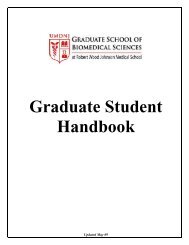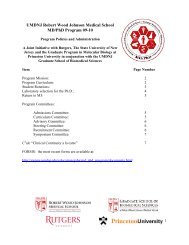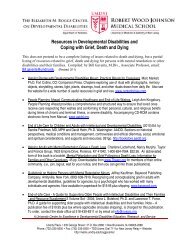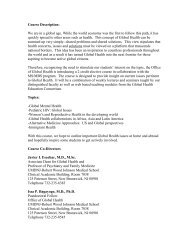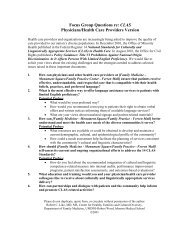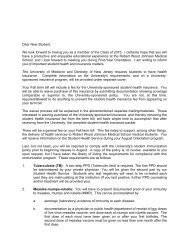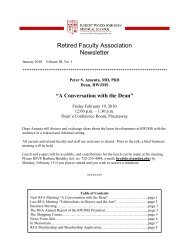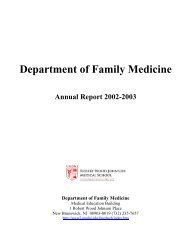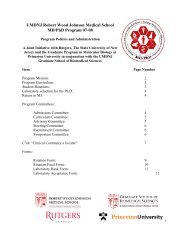Robert Wood Johnson Medicine • Spring 2011 • Population Science
Robert Wood Johnson Medicine • Spring 2011 • Population Science
Robert Wood Johnson Medicine • Spring 2011 • Population Science
Create successful ePaper yourself
Turn your PDF publications into a flip-book with our unique Google optimized e-Paper software.
RWJMS Looks to Launch<br />
Accountable Care Organization<br />
The Patient Protection<br />
and Affordable Care<br />
Act, which the U.S.<br />
Congress passed in 2010, will<br />
gradually but profoundly<br />
change the landscape of<br />
health care. One of the<br />
reform-related changes is the<br />
development of accountable<br />
care organizations (ACOs),<br />
a model already successfully<br />
used at the Mayo and<br />
Cleveland Clinics. These<br />
integrated delivery systems<br />
convene under one umbrella<br />
the many stakeholders involved<br />
in health care delivery,<br />
including patients, physicians,<br />
hospitals, and payers.<br />
In <strong>2011</strong>, UMDNJ-<strong>Robert</strong><br />
<strong>Wood</strong> <strong>Johnson</strong> Medical<br />
School is working to launch<br />
<strong>Robert</strong> <strong>Wood</strong> <strong>Johnson</strong> Partners,<br />
one of the few ACOs<br />
affiliated with an academic<br />
health campus. “Academic<br />
health campuses are ideally<br />
suited to the goals of the<br />
ACO,” says Alfred F. Tallia,<br />
MD ’78, MPH, professor<br />
and chair, Department of<br />
Family <strong>Medicine</strong> and Community<br />
Health. “We are<br />
committed to achieving<br />
excellence in each of our<br />
missions: in clinical care,<br />
education, scientific discovery,<br />
and community health.<br />
Together, these missions reinforce<br />
the reform-related<br />
goals of an ACO, such as<br />
improving the quality of<br />
health care, increasing efficiencies,<br />
reducing costs, and<br />
eliminating health care<br />
inequalities.”<br />
The ACO system emphasizes<br />
quality over quantity.<br />
Providers will be paid based<br />
on outcomes achieved,<br />
rather than on the volume<br />
of services provided. It is<br />
hoped that this incentive will<br />
provide physicians with the<br />
freedom to focus on improving<br />
the underlying systems of<br />
care. The all-faculty <strong>Robert</strong><br />
<strong>Wood</strong> <strong>Johnson</strong> Medical<br />
Group will be just one of<br />
the clinical providers in the<br />
new ACO, which will also<br />
include volunteer faculty<br />
and physicians at hospitals<br />
affiliated with RWJMS and<br />
<strong>Robert</strong> <strong>Wood</strong> <strong>Johnson</strong> University<br />
Hospital (RWJUH).<br />
Dr. Tallia anticipates that the<br />
new ACO will serve 200,000<br />
people in a six-county area<br />
of central New Jersey.<br />
“Given the changes driven<br />
by health care reform, all<br />
providers of care will need<br />
to be more efficient than ever<br />
before in delivering their<br />
services,” explained Stephen<br />
K. Jones, FACHE, president<br />
and chief executive officer,<br />
RWJUH. “Academic medical<br />
centers like ours are best<br />
positioned to take the lead<br />
nationally in shaping this<br />
new system. We believe that<br />
the ACO model — which is<br />
driven by quality, not quantity,<br />
of care — is a natural<br />
extension of our mission<br />
and allows us to integrate<br />
Alfred F. Tallia, MD ’78, MPH<br />
“We are committed to<br />
achieving excellence<br />
in each of our<br />
missions: in clinical<br />
care, education,<br />
scientific discovery,<br />
and community<br />
health. Together, these<br />
missions reinforce<br />
the reform-related<br />
goals of an ACO,<br />
such as improving the<br />
quality of health care,<br />
increasing efficiencies,<br />
reducing costs, and<br />
eliminating health care<br />
inequalities.”<br />
— Alfred F. Tallia, MD ’78, MPH<br />
our efforts with faculty and<br />
private physicians in meeting<br />
the needs of our patients.”<br />
Patients will choose an<br />
ACO supported “medical<br />
home” for their health care.<br />
Medical homes are primary<br />
care–oriented practices that<br />
promote well-being through<br />
enhanced relationships between<br />
patients and members<br />
of a practice team.<br />
They focus care on the<br />
full range of cost-effective<br />
services for individuals<br />
and families —<br />
from prevention and<br />
acute care to chronic<br />
disease management.<br />
Working with the<br />
health care team,<br />
patients would first identify<br />
their own health care objectives<br />
and develop a coordinated<br />
plan to reach them.<br />
Using the resources of the<br />
system, they would be connected<br />
to a gym, a counselor,<br />
or a nutritionist. Second, if<br />
they pursue their goals conscientiously,<br />
they would be<br />
rewarded with lower insurance<br />
rates by their payer,<br />
who will also be a member<br />
of the ACO.<br />
Patients would have access<br />
to important parts of their<br />
electronic medical records<br />
such as medication lists, medication<br />
allergies, and laboratory<br />
data. They can ask their<br />
physician a question using<br />
electronic messaging. “If<br />
people can more successfully<br />
engage with us to develop<br />
their own healthcare goals,”<br />
says Dr. Tallia, “they are<br />
much more likely to achieve<br />
those goals and less likely to<br />
get lost within the healthcare<br />
system. ACOs will facilitate<br />
this by aligning everyone<br />
to meet those shared<br />
goals.”<br />
— K.O’N.<br />
JOHN EMERSON<br />
<strong>Robert</strong> <strong>Wood</strong> <strong>Johnson</strong> ■ MEDICINE 5



